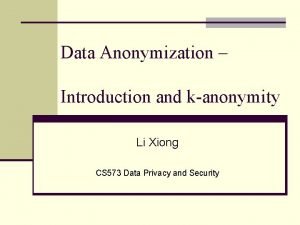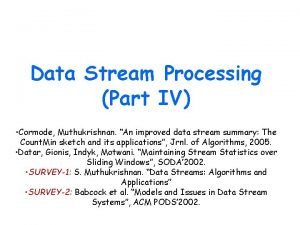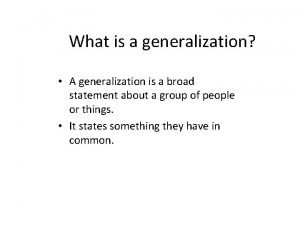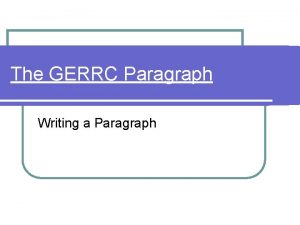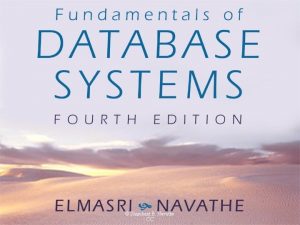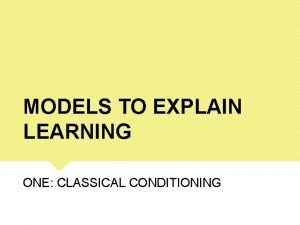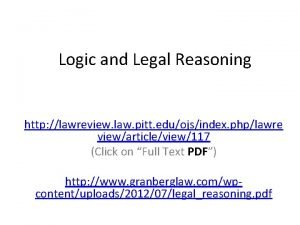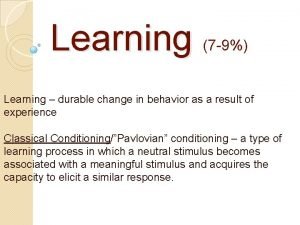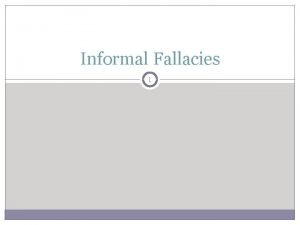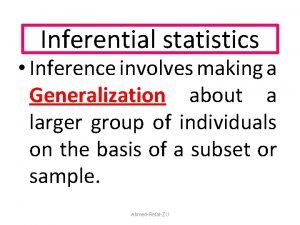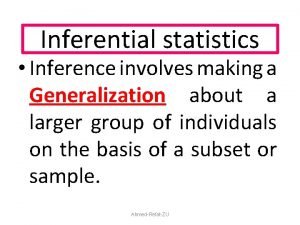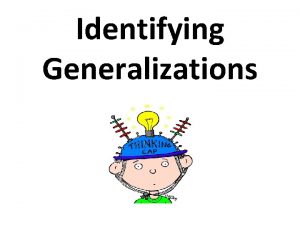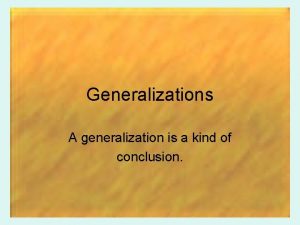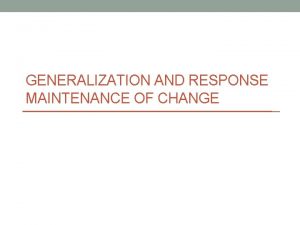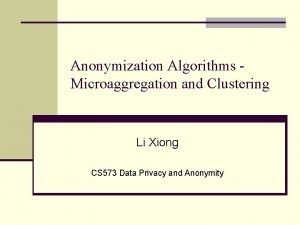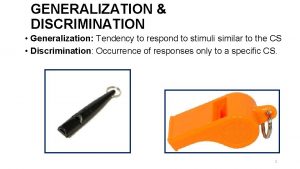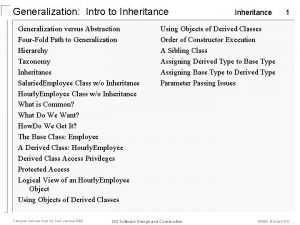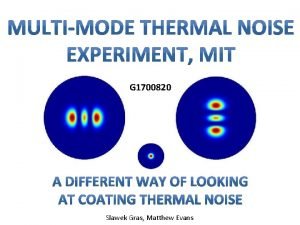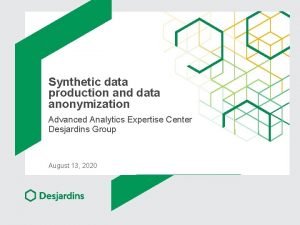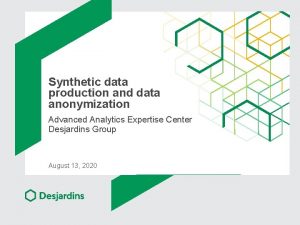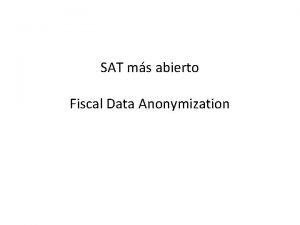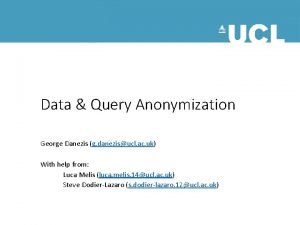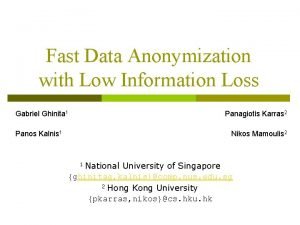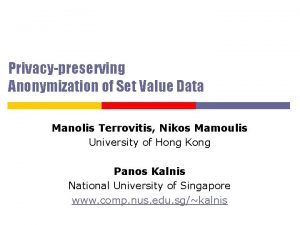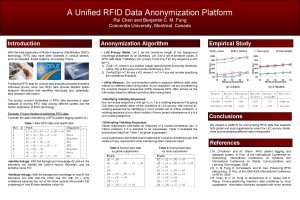Data Anonymization Generalization Algorithms Li Xiong Slawek Goryczka































![Mondrian Piet Mondrian [1872 -1944] Mondrian Piet Mondrian [1872 -1944]](https://slidetodoc.com/presentation_image_h2/16e09ed362fa77d6e52399f13b9e7cad/image-32.jpg)




















- Slides: 52

Data Anonymization Generalization Algorithms Li Xiong, Slawek Goryczka CS 573 Data Privacy and Anonymity

Generalization and Suppression • Generalization Suppression Replace the value with a less specific but semantically consistent value Do not release a value at all # Zip Age Nationality Condition 1 41076 < 40 * Heart Disease 2 48202 < 40 * Heart Disease 3 41076 < 40 * Cancer 4 48202 < 40 * Cancer

Complexity Search Space: • Number of generalizations = If we allow generalization to a different level for each value of an attribute: • Number of generalizations = 3

Hardness result Given some data set R and a QI Q, does R satisfy k-anonymity over Q? Easy to tell in polynomial time, NP! Finding an optimal anonymization is not easy NP-hard: reduction from k-dimensional perfect matching A polynomial solution implies P = NP A. Meyerson and R. Williams. On the complexity of optimal k-anonymity. In PODS’ 04.

Anonymization Strategies Local suppression Delete individual attribute values e. g. <Age=50, Gender=M, State=CA> Global attribute generalization Replace specific values with more general ones for an attribute Numeric data: partitioning of the attribute domain into intervals, e. g. , Age = {[1 -10], . . . , [91 -100]} Categorical data: generalization hierarchy supplied by users, e. g. , Gender = {M, F} 01/31/12 5

k-Anonymization with Suppression k-Anonymization with suppression Global attribute generalization with local suppression of outlier tuples. Terminologies Dataset: D Anonymization: {a 1, …, am} Equivalent classes: E 01/31/12 6

Finding Optimal Anonymization Optimal anonymization determined by a cost metric Cost metrics Discernability metric: penalty for nonsuppressed tuples and suppressed tuples Classification metric R. Bayardo and R. Agrawal. Data Privacy through Optimal k-Anonymization. (ICDE 2005) 01/31/12 7

Modeling Anonymizations Assume a total order over the set of all attribute domains Set representation for anonymization e. g. , Age: <[10 -29], [30 -49]>, Gender: <[M or F]>, Marital Status: <[Married], [Widowed or Divorced], [Never Married]> {1, 2, 4, 6, 7, 9} -> {2, 7, 9} Power set representation for entire anonymization space 01/31/12 Power set of {2, 3, 5, 7, 8, 9} - order of 2 n! {} – most general anonymization {2, 3, 5, 7, 8, 9} – most specific anonymization 8

Optimal Anonymization Problem Goal Find the best anonymization in the powerset with the lowest cost Algorithm set enumeration search through tree expansion - size 2 n Top-down depth first search Heuristics Cost-based pruning Dynamic tree rearrangement 01/31/12 9 Set enumeration tree over powerset of {1, 2, 3, 4}

Node Pruning through Cost Bounding Intuitive idea prune a node H if none of its descendents can be optimal Cost lower-bound of subtree of H 10 Cost of suppressed tuples bounded by H Cost of non-suppressed tuples bounded by A H A 01/31/12

Useless Value Pruning Intuitive idea Prune useless values that have no hope of improving cost Useless values Only split equivalence classes into suppressed equivalence classes (size < k) 01/31/12 11

Tree Rearrangement Intuitive idea Dynamically reorder tree to increase pruning opportunities Heuristics sort the values based on the number of equivalence classes induced 01/31/12 12

Comments Interesting things to think about Domains without hierarchy or total order restrictions Other cost metrics Global generalization vs. local generalization 01/31/12 13

Taxonomy of Generalization Algorithms Top-down specialization vs. bottom-up generalization Global (single dimensional) vs. local (multidimensional) Complete (optimal) vs. greedy (approximate) Hierarchy-based (user defined) vs. partitionbased (automatic) K. Le. Ferve, D. J. De. Witt, and R. Ramakrishnan. Incognito: Efficient Full-Domain k-Anonymity. In SIGMOD 05

Generalization algorithms Early systems µ-Argus, Hundpool, 1996 - Global, bottom-up, greedy Datafly, Sweeney, 1997 - Global, bottom-up, greedy k-Anonymity algorithms All. Min, Samarati, 2001 - Global, bottom-up, complete, impractical Min. Gen, Sweeney, 2002 - Global, bottom-up, complete, impractical Bottom-up generalization, Wang, 2004 – Global, bottom-up, greedy TDS (Top-Down Specialization), Fung, 2005 - Global, top-down, greedy K-OPTIMIZE, Bayardo, 2005 – Global, top-down, partition-based, complete Incognito, Le. Fevre, 2005 – Global, bottom-up, hierarchy-based, complete Mondrian, Le. Fevre, 2006 – Local, top-down, partition-based, greedy

Mondrian Top-down partitioning Greedy Local (multidimensional) – tuple/cell level

Global Recoding Mapping domains of quasi-identifiers to generalized or altered values using a single function Notation Dxi is the domain of attribute Xi in table T Single Dimensional φi : Dxi D’ for each attribute Xi of the quasiid φi applied to values of Xi in tuple of T

Local Recoding Multi-Dimensional Recode domain of value vectors from a set of quasi-identifier attributes φ : Dx 1 x … x Dxn D’ φ applied to vector of quasi-identifier attributes in each tuple in T

Partitioning Single Dimensional For each Xi, define non-overlapping single dimensional intervals that covers Dxi Use φi to map x ε Dx to a summary stat Strict Multi-Dimensional Define non-overlapping multi-dimensional intervals that covers Dx 1… Dxd Use φ to map (xx 1…xxd) ε Dx 1…Dxd to a summary stat for its region

Global Recoding Example k=2 Quasi Identifiers Age, Sex, Zipcode Single Dimensional Partitions Age : {[25 -28]} Sex: {Male, Female} Zip : {[53710 -53711], 53712} Multi-Dimensional Partitions {Age: [25 -26], Sex: Male, Zip: 53711} {Age: [25 -27], Sex: Female, Zip: 53712} {Age: [27 -28], Sex: Male, Zip: [53710 -53711]}

Global Recoding Example 2 k=2 Quasi Identifiers Age, Zipcode Patient Data Single Dimensional Multi-Dimensional

Greedy Partitioning Algorithm Problem Need an algorithm to find multi-dimensional partitions Optimal k-anonymous strict multi-dimensional partitioning is NP-hard Solution Use a greedy algorithm Based on k-d trees Complexity O(n logn)

Greedy Partitioning Algorithm

Algorithm Example k=2 Dimension determined heuristically Quasi-identifiers Zipcode Age Patient Data Anonymized Data

Algorithm Example Iteration # 1 (full table) partition ` dim = Zipcode fs split. Val = 53711 LHS RHS

Algorithm Example continued Iteration # 2 (LHS from iteration # 1) partition ` dim = Age fs split. Val = 26 LHS RHS

Algorithm Example continued Iteration # 3 (LHS from iteration # 2) partition ` No Allowable Cut ` Summary: Age = [25 -26] Zip= [53711] Iteration # 4 (RHS from iteration # 2) partition ` No Allowable Cut Summary: Age = [27 -28] Zip= [53710 - 53711]

Algorithm Example continued Iteration # 5 (RHS from iteration # 1) partition ` No Allowable Cut ` Summary: Age = [25 -27] Zip= [53712]

Experiment Adult dataset Data quality metric (cost metric) Discernability Metric (CDM) CDM = ΣEquivalent. Classes E |E|2 Assign a penalty to each tuple Normalized Avg. Eqiv. Class Size Metric (CAVG) CAVG = (total_records/total_equiv_classes)/k

Comparison results Full-domain method: Incognito Single-dimensional method: K-OPTIMIZE

Data partitioning comparison
![Mondrian Piet Mondrian 1872 1944 Mondrian Piet Mondrian [1872 -1944]](https://slidetodoc.com/presentation_image_h2/16e09ed362fa77d6e52399f13b9e7cad/image-32.jpg)
Mondrian Piet Mondrian [1872 -1944]

Distributed Anonymization

Anonymization Example (attack) Privacy is defined as k-anonymity (k = 2).

Anonymization Example (attack) Privacy is defined as k-anonymity (k = 2).

Anonymization Example (attack) Privacy is defined as k-anonymity (k = 2).

m-Privacy A set of anonymized records is mprivate with respect to a privacy constraint C, e. g. , k-anonymity, if any coalition of m parties (m-adversary) is not able to breach privacy of remaining records.

m-Anonymization Example An attacker is a single data provider (1 -privacy)

Parameters m and C Number of malicious parties: m m = 0 (0 -privacy) is when the coalition of parties is empty, but each data recipient can be malicious m = n-1 means that no party trusts any other (anonymize-and-aggregate) Privacy constraint C: m-privacy is orthogonal to C and inherits all its advantages and drawbacks

m-Adversary Modeling If a coalition of attackers cannot breach privacy of records, then any its subcoalition will not be able to do so as well.

Equivalence Group Monotonicity Adding new records to a private equiv. group will not change the privacy fulfillment! To verify m-privacy it is enough to determine privacy fulfillment only for m-adversaries, EG monotonic privacy constraints: k-anonymity, simple l-diversity, … Not EG monotonic constraints: t -closeness, . . .

Pruning Strategies Number of coalitions to verify: exponential to number of providers, but with efficient pruning strategies should be OK!

Verification Algorithms top-down algorithm, bottom-up algorithm, binary algorithm.

Anonymizer for m-Privacy To multidimensional data add one more attribute – data provider, which can be used as any other attribute in anonymization. Provider Age Zip

Anonymizer for m-Privacy To multidimensional data add one more attribute – data provider, which can be used as any other attribute in anonymization. Provider Age Zip

Anonymizer for m-Privacy To multidimensional data add one more attribute – data provider, which can be used as any other attribute in anonymization. Provider Age Zip

m-Anonymizer (diagram)

Experiments Setup Dataset: the Adult dataset, Census database. Attributes: age, workclass, education, marital- status, race, gender, native-country, occupation (sensitive attribute with 14 possible values). Privacy defined as a conjunction of k-anonymity and l-diversity. Metrics: Runtime Query error – compares results of random queries issued over original and anonymized data

Experiments m-Privacy verification runtime for different algorithms vs. m Average number of records per provider = 10 Average number of records per provider = 50

Experiments m-Anonymizer runtime and query error for different anonymizers vs. size of attacking coalitions m

Experiments m-Anonymizer runtime and query error for different anonymizers vs. number of data records

Q&A Thank you!
 Amnesia data anonymization
Amnesia data anonymization Anonymization tool
Anonymization tool Unforgettable journey quotes
Unforgettable journey quotes Nalee xiong
Nalee xiong Vong xiong
Vong xiong Li xiong
Li xiong Weiwei xiong
Weiwei xiong Xiong jie
Xiong jie Ning yun wu xiong
Ning yun wu xiong Jack xiong
Jack xiong Hmong shaman rituals
Hmong shaman rituals Professor ajit diwan
Professor ajit diwan Cos423
Cos423 Data structures and algorithms tutorial
Data structures and algorithms tutorial Information retrieval data structures and algorithms
Information retrieval data structures and algorithms Data structures and algorithms bits pilani
Data structures and algorithms bits pilani Data structures and algorithms iit bombay
Data structures and algorithms iit bombay Muthukrishnan data stream algorithms
Muthukrishnan data stream algorithms Algorithms + data structures = programs
Algorithms + data structures = programs Data structures and algorithms
Data structures and algorithms Data structures and algorithms
Data structures and algorithms Ian munro waterloo
Ian munro waterloo Information retrieval data structures and algorithms
Information retrieval data structures and algorithms Data structures and algorithms
Data structures and algorithms All birds have wings is an example of faulty generalization
All birds have wings is an example of faulty generalization Generalization of paragraph
Generalization of paragraph Acquisition, fluency maintenance generalization examples
Acquisition, fluency maintenance generalization examples Generalization in database
Generalization in database Pavlov watson skinner
Pavlov watson skinner What are the propaganda techniques
What are the propaganda techniques Patriotism persuasive technique
Patriotism persuasive technique Phonics generalization
Phonics generalization Fallacy of composition
Fallacy of composition Grammatical signals
Grammatical signals Generalization classical conditioning
Generalization classical conditioning Time pattern organizer example
Time pattern organizer example Broad generalization
Broad generalization Hasty generalization
Hasty generalization Logic is the beginning of wisdom not the end
Logic is the beginning of wisdom not the end Missing the point examples
Missing the point examples Examples of hasty generalization
Examples of hasty generalization Inductive generalization
Inductive generalization Conditioned stimulus psychology definition
Conditioned stimulus psychology definition Fictional character
Fictional character Classical conditioning generalization
Classical conditioning generalization Formal and informal fallacies
Formal and informal fallacies Inferential statistics table
Inferential statistics table What is an alternative hypothesis
What is an alternative hypothesis What is deductive reasoning
What is deductive reasoning Read the paragraph below make a generalization
Read the paragraph below make a generalization Conclusion and generalization examples
Conclusion and generalization examples Sample generalization
Sample generalization Maintenance generalization
Maintenance generalization





